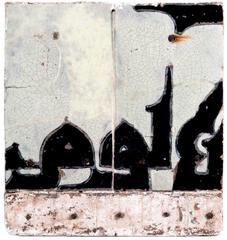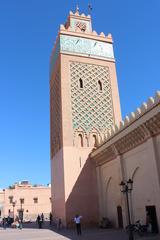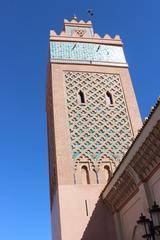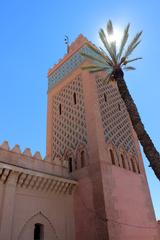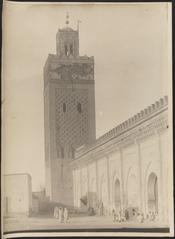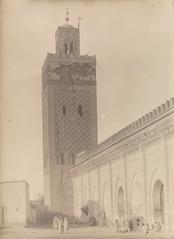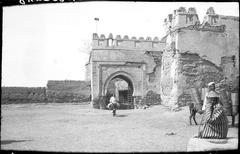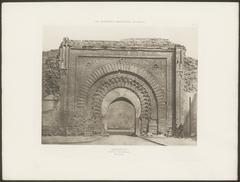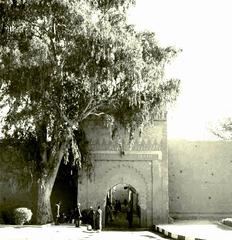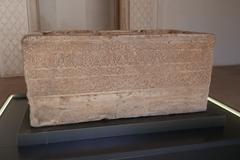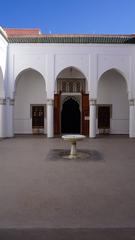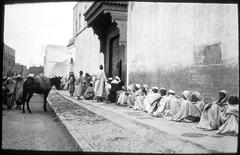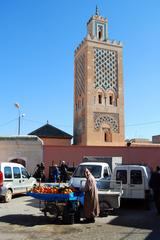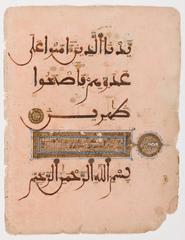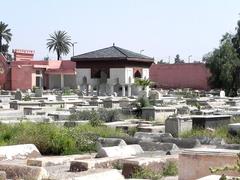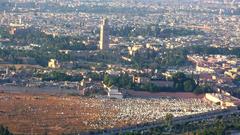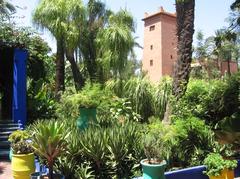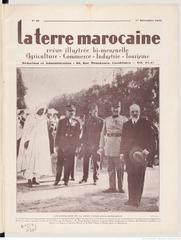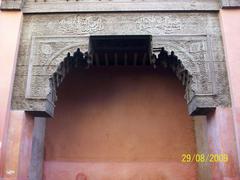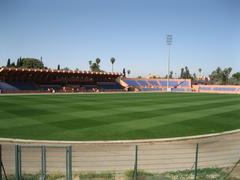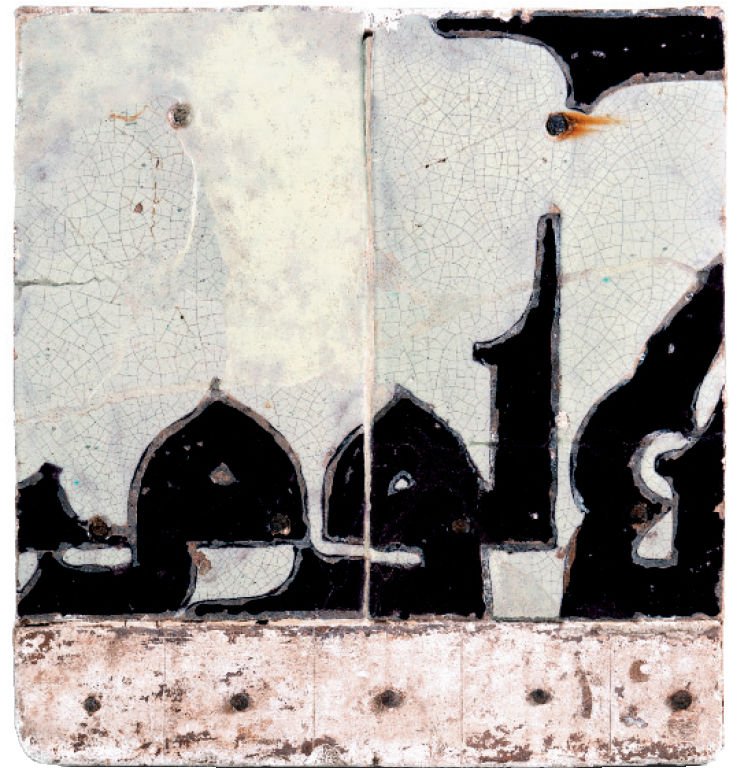
Al-Mansour Mosque: Visiting Hours, Tickets, and Historical Significance in Marrakesh
Date: 14/06/2025
Introduction
Located in Marrakesh’s historic Kasbah district, the Al-Mansour Mosque—also known as the Kasbah Mosque or Mosque of Moulay al-Yazid—is a prominent symbol of Morocco’s Islamic heritage and architectural excellence. Built during the height of the Almohad dynasty between 1185 and 1190 CE, this mosque blends historical, religious, and political significance. Although access to the mosque’s interior is reserved for Muslims, its striking exterior, gardens, and vibrant surroundings captivate visitors from around the world. This guide details the mosque’s history, architectural features, visitor information, and practical travel tips to ensure a meaningful and respectful visit.
For the latest updates and travel resources, visit trusted platforms like Morocco Photo Tours, Marrakech Tricks, and Travel Morocco Today.
Table of Contents
- Historical Background
- Almohad Religious and Political Context
- Architectural Features and Innovations
- Visiting Hours, Tickets, and Entry Policies
- Visitor Tips and Dress Code
- Accessibility and Facilities
- Nearby Attractions
- Photography Guidelines
- FAQ
- Summary Table: Key Practical Information
- References
Historical Background
Constructed under Caliph Yaqub al-Mansur, the Kasbah Mosque was designed as the primary congregational mosque for Marrakesh’s royal kasbah district. Its establishment reflected the Almohads’ vision of integrating religious authority with political power and urban planning. The mosque’s strategic position near Bab Agnaou gate and the Saadian Tombs reinforced its significance as a spiritual, administrative, and ceremonial center.
Almohad Religious and Political Context
The Almohad dynasty, originating from Berber roots, made Marrakesh their capital and launched major religious and architectural reforms. The mosque was intended as the Friday mosque for the caliph and his court, symbolizing the close relationship between political leadership and Islamic faith. Its construction was funded, in part, by the spoils from the Battle of Alarcos, and it later became central to the city’s religious festivals and dynastic ceremonies (Morocco Photo Tours, Marrakech Tricks).
Architectural Features and Innovations
Almohad Design Elements
The mosque exemplifies Almohad architecture with:
- Geometric precision and symmetry
- Horseshoe arches framing entrances and interior spaces
- Rectangular prayer hall and expansive courtyard
- Red sandstone exterior, reflecting Marrakesh’s “Red City” character (EAA)
- Ornate minaret, clad in green tiles and geometric motifs, serving as a visual anchor in the district
Interior and Courtyards
The prayer hall features rows of horseshoe arches, whitewashed walls, and carved stucco panels. The central courtyard (sahn) provides light and ventilation, while exterior gardens with palms and citrus trees offer an oasis of tranquility (Travel Morocco Today).
Craftsmanship
Intricate stucco arabesques, calligraphy, and zellij tilework decorate the mosque’s facades and interiors, exemplifying Moroccan Islamic artistry.
Visiting Hours, Tickets, and Entry Policies
- Visiting Hours: The mosque is open daily from 8:00 AM to 6:00 PM for exterior viewing. The prayer hall is open only to Muslims for religious observance.
- Tickets: No tickets are required for viewing the mosque’s exterior and gardens; entry is free.
- Entry Policy: Non-Muslims are not permitted inside the prayer hall, in accordance with Moroccan law and tradition (Meet Me In Departures).
- Accessibility: The grounds are generally accessible by foot, but uneven surfaces may pose challenges for visitors with mobility impairments.
Visitor Tips and Dress Code
- Dress Code: Both men and women should dress modestly—shoulders, arms, and knees must be covered. Women may wish to carry a scarf for additional coverage (Blue Mosque; Travel Morocco Today).
- Best Times to Visit: Early mornings or late afternoons offer cooler temperatures and softer light for photography.
- Behavior: Maintain a respectful demeanor, keep noise low, and avoid eating or drinking near the mosque.
Accessibility and Facilities
- Location: Situated on Rue de la Kasbah, the mosque is accessible on foot from major landmarks like Jemaa el-Fnaa and Bahia Palace (Grumpy Camel).
- Facilities: Public restrooms are limited; nearby cafes or restaurants may offer facilities for paying customers.
- Safety: Use secure bags to prevent pickpocketing and wear comfortable shoes for cobblestone streets (Vagrants of the World).
Nearby Attractions
- Saadian Tombs: A historic necropolis with exquisite decoration
- Royal Palace: Official residence of the Moroccan king
- Bahia Palace: Lush gardens and ornate royal interiors
- El Badi Palace: Ruins of a once-grand royal residence
- Rooftop Cafes: Excellent for panoramic views and relaxation (While I’m Young)
Photography Guidelines
- Exterior Photography: Allowed and encouraged—but avoid photographing worshippers without permission.
- Best Lighting: Early morning or late afternoon
- Drones/Professional Equipment: Not permitted without special authorization
FAQ
Can non-Muslims enter the mosque?
No, only Muslims may enter the prayer hall. The exterior, courtyards, and gardens are accessible to all.
Is there an entrance fee?
No, the mosque’s exterior and gardens are free to visit.
Are guided tours available?
Yes, local guides can provide historical context and help navigate the Kasbah district.
Is the mosque wheelchair accessible?
Access is limited due to uneven streets; it’s best to arrange assistance in advance if needed.
What language is spoken in the area?
Arabic is primary, with French widely spoken and English increasingly common in tourist sectors.
Summary Table: Key Practical Information
| Aspect | Details |
|---|---|
| Location | Rue de la Kasbah, Kasbah district, Marrakesh |
| Entry | Muslims only for interior; exterior open to all |
| Tickets | No tickets required for mosque exterior and gardens |
| Dress Code | Modest attire; shoulders, arms, and knees covered |
| Nearby Attractions | Saadian Tombs, Bahia Palace, Royal Palace, rooftop cafes |
| Best Time to Visit | Early morning or late afternoon |
| Accessibility | Limited wheelchair access; uneven streets |
| Facilities | Limited restrooms; cafes nearby |
| Safety | Watch for pickpockets; use secure bags |
| Language | Arabic, French, some English |
| Photography | Exterior only; avoid photographing people without consent |
Conclusion
The Al-Mansour Mosque remains a living testament to Marrakesh’s rich Islamic tradition and Almohad architectural legacy. While non-Muslims cannot enter the prayer hall, the mosque’s exterior, gardens, and vibrant Kasbah district offer a wealth of history, culture, and photographic opportunities. Plan your visit with an understanding of local customs, dress codes, and respectful etiquette for a rewarding experience. For the most up-to-date information and personalized travel guidance, consider downloading the Audiala app and exploring additional resources.
References
- Kasbah Mosque Marrakesh: Visiting Hours, Tickets, History & Travel Tips, 2025, Morocco Photo Tours (https://morocco-phototours.com/photo-tour-kasbah-mosque-moulay-yazid/)
- Visiting Al-Mansour Mosque in Marrakesh: History, Tickets, Hours, and Cultural Insights, 2025, Marrakech Tricks (https://marrakechtricks.com/blog/kasbah-mosque)
- Visiting Al-Mansour Mosque in Marrakesh: Hours, Tickets, History & Travel Tips, 2025, Travel Morocco Today (https://travelmoroccotoday.com/two-days-in-marrakech-itinerary/)
- Al-Mansour Mosque Visiting Hours, Tickets & Guide to Marrakesh Historical Sites, 2025, Grumpy Camel (https://www.grumpycamel.com/tips-for-visiting-marrakech/)
- Visiting Marrakesh in June: Weather, Festivals, Things to Do, 2025, Malika in Morocco (https://www.malika-in-morocco.com/post/visiting-marrakech-in-june-weather-festivals-things-to-do)
- Marrakech Red City Historical Overview, 2025, World History Journal (https://worldhistoryjournal.com/2025/03/21/marrakesh-red-city/)
- Tips for Visiting Marrakech, 2025, Meet Me In Departures (https://meetmeindepartures.com/what-to-wear-in-marrakech/)
- How to Dress Appropriately When Visiting Mosques, 2025, Blue Mosque (https://www.bluemosque.net/how-to-dress-appropriately-when-visiting-mosques.html)
- Marrakech Four Day Itinerary & Best Things to Do, 2025, While I’m Young (https://www.whileimyoung.com/marrakech-four-day-itinerary-best-things-to-do/)
